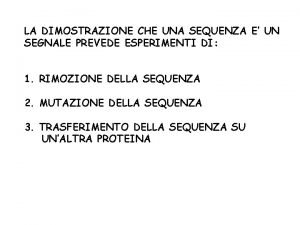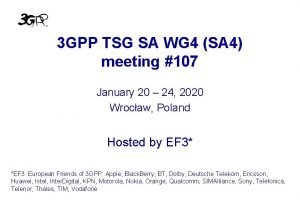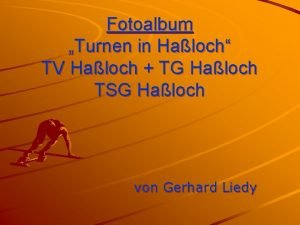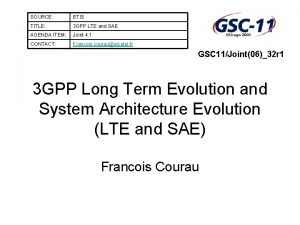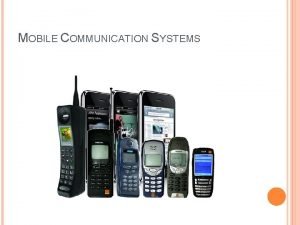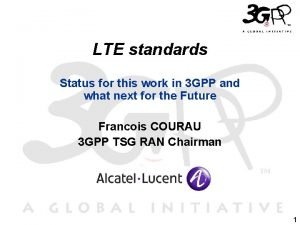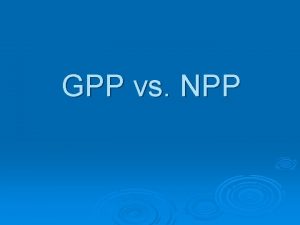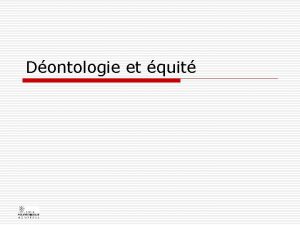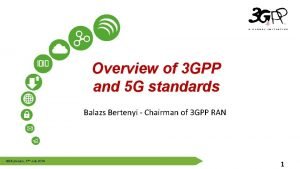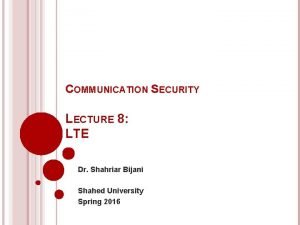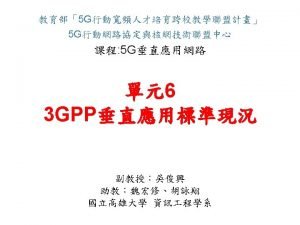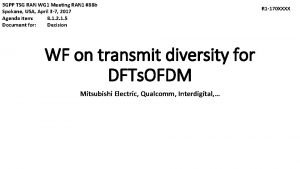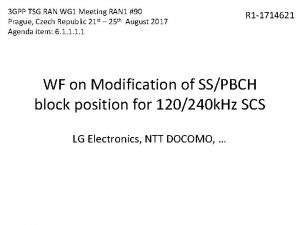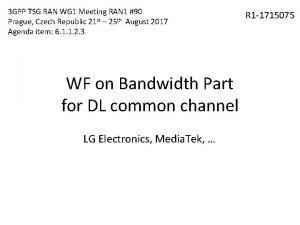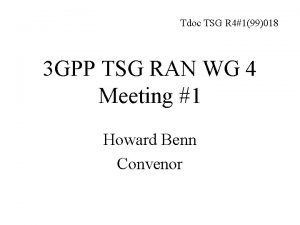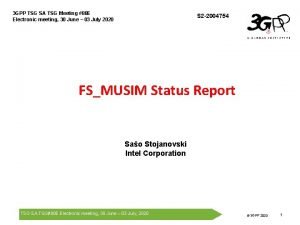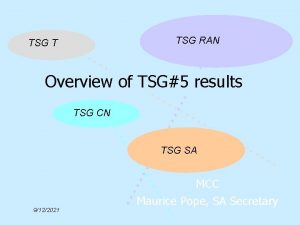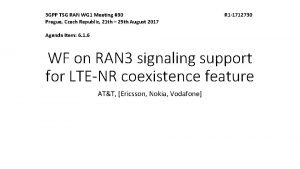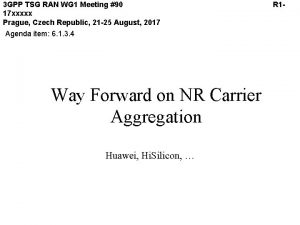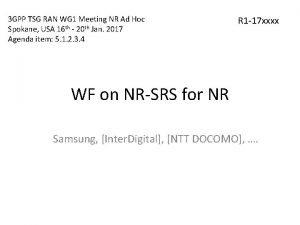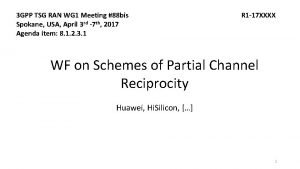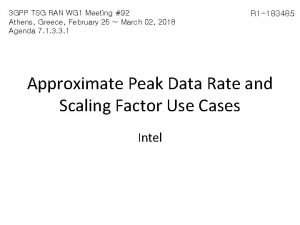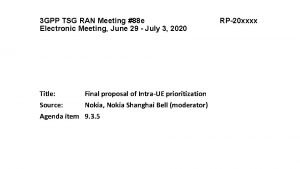3 GPP TSG RAN WG 1 Meeting 90








![Background – Supported CC/[BWP] BW › Ref: Chairman’s notes: RAN 4#84, August 2017 SCS[k Background – Supported CC/[BWP] BW › Ref: Chairman’s notes: RAN 4#84, August 2017 SCS[k](https://slidetodoc.com/presentation_image_h/cea82eb69842d514713476cf482648f6/image-9.jpg)






- Slides: 15

3 GPP TSG RAN WG 1 Meeting #90 b Prague, Czech Republic, 9 th – 13 th October, 2017 Agenda item 7. 2. 3. 5 R 1 -1718968 WF on SRS for NR Ericsson, Qualcomm, Huawei, Hi. Silicon, ZTE, Sanechips, Mitsubishi, Sony, Nokia, NSB, NTT Docomo, AT&T, China Unicom, China Telecom, Vodafone, Intel, Samsung [CMCC, LG, Mediatek, CATT, Interdigital, vivo, OPPO, …]

Background (RAN 1 -NR AH#1) › Agreements: – NR supports periodic and semi-persistent NR-SRS transmission. › Note aperiodic SRS transmission has been agreed – Out of K ≥ 1 configured NR-SRS resources: › For aperiodic transmission, the UE can be configured to transmit a subset of or all K NR-SRS resources with no precoding, the same or different precoding › For periodic and semi-persistent transmission, the UE can be configured to transmit K NR-SRS resources with no precoding, the same or different precoding – FFS details related position & timing of SRS transmission (including configurable) – NR supports SRS transmission including › Number of SRS ports are 1, 2, 4, FFS 3, 8 (possibly other values) › Comb levels are 2 and 4 › Configurable frequency hopping (details FFS) – Clarify the following agreed configurations are applicable to each NR-SRS resource from K configured NR-SRS resources: › NR-SRS bandwidth › Number of CP-OFDM/DFT-S-OFDM symbols › Number of SRS ports › Comb level Public | © Ericsson AB 2017 | 2017 -03 -31 | Page 2

Background (RAN 1#88 bis) › Agreements: – A UE can be configured with an X-port SRS resource, where the SRS resource spans one or multiple OFDM symbols within a single slot › FFS where all of the X SRS ports are sounded in each OFDM symbol – FFS at least for the purposes of CSI acquisition: › FFS a multi-symbol SRS resource can be configured such that the X SRS ports in each OFDM symbol are transmitted in different locations of the band in different OFDM symbols in the slot in a frequency hopping manner - Note: This allows sounding a larger part of (or the full) UE bandwidth using narrower band SRS transmissions - Note: at any OFDM symbol, all X ports are sounded in the same portion of the band › Note: Consider UE RF implementation aspects on SRS design that may place constraints on the design of the symbol-wise hopping pattern - e. g. , Required time for frequency re-tuning (if re-tuning needed) or transient period if re-tuning is not needed Public | © Ericsson AB 2017 | 2017 -03 -31 | Page 3

Background (RAN 1 #89) › Agreements: – NR supports configuration of an X-port SRS resource spanning N adjacent OFDM symbols within the same slot where › N = 1, 2, 4 at least › Agreements: – Support switching between partial bands for SRS transmissions in a CC › At least when an UE is not capable of simultaneous transmission in partial bands in a CC › Consider RF retuning requirement for partial band switching – Note: definition of partial band is equivalent to “bandwidth part” definition in wider bandwidth operation agenda item Public | © Ericsson AB 2017 | 2017 -03 -31 | Page 4

Background (RAN 1 -NR AH#2) › Agreements: – Support g. NB to configure one or more groups where each group contains one or more SRS resource(s) to UE › Note: different groups may be for different purposes, e. g. , one or more groups for beam management, one for DL CSI acquisition, one for UL CSI acquisition, etc. › Agreements: – Support antenna switching for SRS transmission within a carrier: › FFS: Support at least [2 Tx, 4 Tx] switching › Agreements: – For NR SRS, support sounding bandwidth in multiple of 4 PRBs › FFS the detailed set of SRS sounding bandwidths to be supported › At least 4 PRBs as SRS sounding bandwidth is supported Public | © Ericsson AB 2017 | 2017 -03 -31 | Page 5

Background (RAN 1#90) › Agreements: – A given X-port SRS resource spans N = 1, 2, or 4 adjacent symbols within a slot where all X ports are mapped to each symbol of the resource, at least the following is supported: › Within the resource, each of the X ports are mapped to the same set of subcarriers in the same set of PRBs in the N SRS symbols › FFS for the case with frequency hopping depending on RAN 4 LS reply › Agreements: – SRS transmitted in an active UL BWP has the same numerology as that configured for that BWP. – For LTE SRS sequences: › NR should support UE specific configured bandwidth based on tree-like SRS bandwidth sets (analogues to LTE) - FFS the parameters used for configuring bandwidth allocation, e. g. whether or not CSRS and BSRS can be reused in a UE specific manner › NR should support to sound substantially all UL PRBs in a BWP - FFS details of SRS bandwidth sets and RE mapping methods - Note that the design shall consider the maximum allowed bandwidth of a BWP › Working assumption: – – SRS sequence for NR is supported for up to [272] PRBs by using LTE SRS sequences generation equation Companies are encouraged to evaluate PAPR and cross correlation properties of these sequences Note [272] PRBs corresponds to the maximum bandwidth support by NR FFS On the set of supported SRS bandwidths Public | © Ericsson AB 2017 | 2017 -03 -31 | Page 6

Background (RAN 1 -NR AH#3) Agreement: – Confirm the working assumption – SRS sequence for NR is supported for up to 272 PRBs by using LTE SRS sequences generation equation – Note: 272 PRBs corresponds to the maximum bandwidth support by NR – FFS: On the set of supported SRS bandwidths Agreement: – SRS ports more than 4 per SRS resource is not supported in Rel-15 Agreement: – For antenna switching for SRS transmission within a carrier, at least support 1 Tx (in the case of UE with 1 T 2 R) and 2 Tx (in the case of UE with 2 T 4 R) antenna switching scheme › Design principle in LTE for SRS transmission can be a starting for the details in NR › FFS: For the case UE with 2 Tx, where one antenna have the capability of 1 Tx to 3 antenna switching, and another antenna have no switching › FFS: SRS transmission for antenna switching and associated SRS resource / resource group configurations › FFS: Antennas in a antenna group can transmit SRS simultaneously, and FFS on antenna indexing in each antenna group › FFS: The relationship between SRS antenna switching and SRS resource hopping considering SRS repetition within one SRS resource › This feature is used at least to acquire downlink channel information Agreement – An SRS resource can be configured to occupy a location within at least the last 6 symbols in a slot. › FFS other location in a slot or using all UL OFDM symbols in a slot depending on the results of antenna switching discussions › From UE perspective, no FDM between SRS and short PUCCH › From UE perspective, when PUSCH is scheduled in a slot, SRS may be configured at least after the scheduled PUSCH and the corresponding DMRS. Study further whether SRS may be configured before the scheduled PUSCH and the corresponding DMRS – Working assumption from RAN 1#90 on SRS short PUCCH prioritization is confirmed Agreement: – NR supports C_SRS and B_SRS to be UE-specifically configurable Public | © Ericsson AB 2017 | 2017 -03 -31 | Page 7

Background – RAN 4 LS Reply on SRS Hopping & Tx Switching › RAN 1 LS from RAN 1#89 – Conclusion: – Send an LS to RAN 4 regarding the following: › RAN 1 is discussing the possibility of enabling SRS hopping within a slot. For an X-port SRS resource spanning N adjacent OFDM symbols within the same slot, all X ports may be sounded as frequently as up to each of the N symbols in a different portion of the band. In addition to other aspects that need to be investigated in RAN 1, RAN 1 is also wondering UE RF implementation aspects that may place constraints on the design (e. g. , total SRS hopping bandwidth) of the hopping pattern, e. g. , required time for frequency re-tuning (if re-tuning needed) or transient period if re-tuning is not needed. Note that RAN 1 also made an agreement as follows (Mattias to copy previous agreements on SRS switching across bandwidth parts) – Draft LS by Mattias (Ericsson) R 1 -1709819, which is endorsed. Final LS approved in R 1 -1709836 › RAN 4 LS Reply: R 4 -1710048 (references [1] R 4 -1702029 and [2] R 4 -1706940) – In general, SRS can be sent on consecutive symbols on the same antenna port. If SRS power is different between consecutive symbols, same timing constrains apply what was indicated in [2]. – For sounding different antenna ports, RAN 4 has agreed that antenna switching time is 15 usec. – If UE is in BW reduction mode and if other BWPs must be sounded, times for changing BW, retuning LO or waking up a new TX chains have already been sent to RAN 1 in LS [1]. – For UE capable of antenna switching but not UL MIMO, UE may use the diversity RX antennas to send SRS. Since the Rx antennas can be located in far corners of the device compared to the primary Tx antennas, there may be additional losses between PA output and antenna feed points. Therefore, UE max power capability of the Rx antenna ports may be reduced. RAN 4 is seeking guidance if UE should compensate for the power difference in the case the Rx port transmit power after compensation is lower than maximum output power capability of the Rx antenna ports or keep the same reduction at all power levels. – Action to RAN 1: › RAN 4 would like RAN 1 to consider the discussion above for their design in SRS hopping. RAN 4 is also requesting information what is expected UE behaviour for compensating the power difference between primary Tx antenna ports and Rx antenna ports. Public | © Ericsson AB 2017 | 2017 -03 -31 | Page 8
![Background Supported CCBWP BW Ref Chairmans notes RAN 484 August 2017 SCSk Background – Supported CC/[BWP] BW › Ref: Chairman’s notes: RAN 4#84, August 2017 SCS[k](https://slidetodoc.com/presentation_image_h/cea82eb69842d514713476cf482648f6/image-9.jpg)
Background – Supported CC/[BWP] BW › Ref: Chairman’s notes: RAN 4#84, August 2017 SCS[k 5 MHz Hz] 10 M Hz 15 M Hz 20 M Hz 25 M Hz 40 M Hz 50 M Hz 60 M 80 MH Hz z 100 MHz 15 25 52 79 106 133 216 270 N. A 30 11 24 38 51 65 106 133 162 217 273 60 N. A 11 18 24 31 51 65 79 107 135 SCS[k. Hz] Public | © Ericsson AB 2017 | 2017 -03 -31 | Page 9 50 MHz 100 MHz 200 MHz 400 MHz 60 66 132 264 N. A 120 32 66 132 264

Proposal SRS Resource Configuration › An X-port SRS resource spans N = 1, 2, or 4 adjacent OFDM symbols within the same slot where all X ports are mapped to each symbol of the resource – When frequency hopping only is configured, the X ports are mapped to potentially different sets of subcarriers in each OFDM symbol of the resource, depending on the hopping pattern – For N = 4, frequency hopping + repetition can be configured where the X ports are mapped to a different set of subcarriers in the second pair OFDM symbol(s) of the resource › Note: Symbol pairs are adjacent – Note: same comb is assumed for different sets of subcarriers – Note: hopping pattern is within the tree structure defined by a given C_SRS, B_SRS, and b_hop – Note: When repetition only is configured, the mapping is covered by previous agreement in RAN 1#90: › “Each of the X ports are mapped to the same set of subcarriers in the same set of PRBs in the N SRS symbols. ” › FFS: NCP SRS resource definition is reused for ECP › FFS: SRS transmission repetition within a slot can be at different power levels to account for relative phase discontinuities from multiple UE Tx chains Public | © Ericsson AB 2017 | 2017 -03 -31 | Page 10

Proposal SRS BW Table › NR supports a single SRS bandwidth configuration table defined in the same way as in 36. 211 where different values of CSRS define the rows and 4 different values of BSRS (0, 1, 2, 3) define the columns › NR strives to follow the following design rules for the SRS bandwidth configuration table › The configuration table includes the 17 unique rows from the 4 LTE tables defined in 36. 211, i. e. , Tables 5. 5. 3. 2 -1, 5. 5. 3. 2 -2, 5. 5. 3. 2 -3, and 5. 5. 3. 2 -4 - Note: this covers SRS bandwidths ≤ 96 PRBs › To the extent possible, the configuration table includes rows for which m. SRS, 0 has a granularity of 8 PRBs in the range 4 – 272 PRBs - In addition, to support as close as possible to full-band sounding for each supported CC/[BWP] bandwidth with N PRBs, the configuration table includes at least one row for which m. SRS, 0 = floor(N/4)*4 - Note: Supported CC/[BWP]s are in the background slides › To support frequency hopping whereby a hopping bandwidth of m. SRS, 0 is fully sounded in N = 1, 2, or 4 OFDM symbols, the configuration table includes rows satisfying the following: › N 0 = 1, N 1 = 2 for rows where m. SRS, 0 is an integer multiple of 8 PRBs › N 0 = 1, N 1 = N 2 = 2 for rows where m. SRS, 0 is an integer multiple of 16 PRBs › NR supports the SRS bandwidth configuration table on the next slide according to these design rules Public | © Ericsson AB 2017 | 2017 -03 -31 | Page 11

Proposal SRS BW Table › Table attached Public | © Ericsson AB 2017 | 2017 -03 -31 | Page 12

Proposal Frequency Hopping within a BWP › Public | © Ericsson AB 2017 | 2017 -03 -31 | Page 13

Proposal Tx Antenna switching › For 1 T 2 R or 2 T 4 R antenna switching within an active BWP of a component carrier, NR supports inter-slot and intra-slot antenna switching – The UE is configured with two SRS resources which are both 1 symbol or both 2 symbols, where › For 1 T 2 R: Both resources are single-port, and the port of the 2 nd resource is associated with a different UE antenna than the port of the 1 st resource › For 2 T 4 R: Both resources are 2 -port, and the port pair of the 2 nd resource is associated with a different UE antenna pair than the port pair of the 1 st resource – For inter-slot antenna switching, the two SRS resources are TDM’d at slot level – For intra-slot antenna switching, the two SRS resources are TDM’d. They may be configured with a guard period of Y symbols in between to account for the Tx switching transient time (e. g. , enough symbols to account for 15 us according to RAN 4, based on UE capability) › The UE does not transmit any other signal during the guard period – For intra-slot, aperiodic triggering of the two SRS resources configured for antenna switching is supported. FFS: aperiodic triggering for inter-slot. › NR supports 1 T 4 R antenna switching within an active BWP of a component carrier – The UE is configured with 4 SRS resources which are all single-symbol and single-port › Each port of the 4 resources is associated with a different UE antenna – FFS: Inter-/intra-slot switching – FFS: Aperiodic triggering of the 4 SRS resources › FFS: how to provide the e. NB with UE requirements on the number of SRS resources and the number of ports per resource for the purposes of Tx antenna switching › FFS: UE behaviour in case of power difference between primary Tx antenna(s) and secondary Rx antenna(s) Public | © Ericsson AB 2017 | 2017 -03 -31 | Page 14

Proposal Sequence hopping and number of root sequences › Down-select one of the following alternatives for group hopping and sequence hopping – Alt-1: 30 sequence groups with 1 or 2 root-sequences per group › If group hopping is enabled, v = 0 › If sequence hopping is enabled, group hopping is disabled – Alt-2: 30 sequence group with 1 or 2 root-sequences per group › If group hopping is enabled, v can be 0 or 1 - FFS how to switch the value of v during group hopping › If sequence hoping is enabled, group hopping is disabled Public | © Ericsson AB 2017 | 2017 -03 -31 | Page 15
